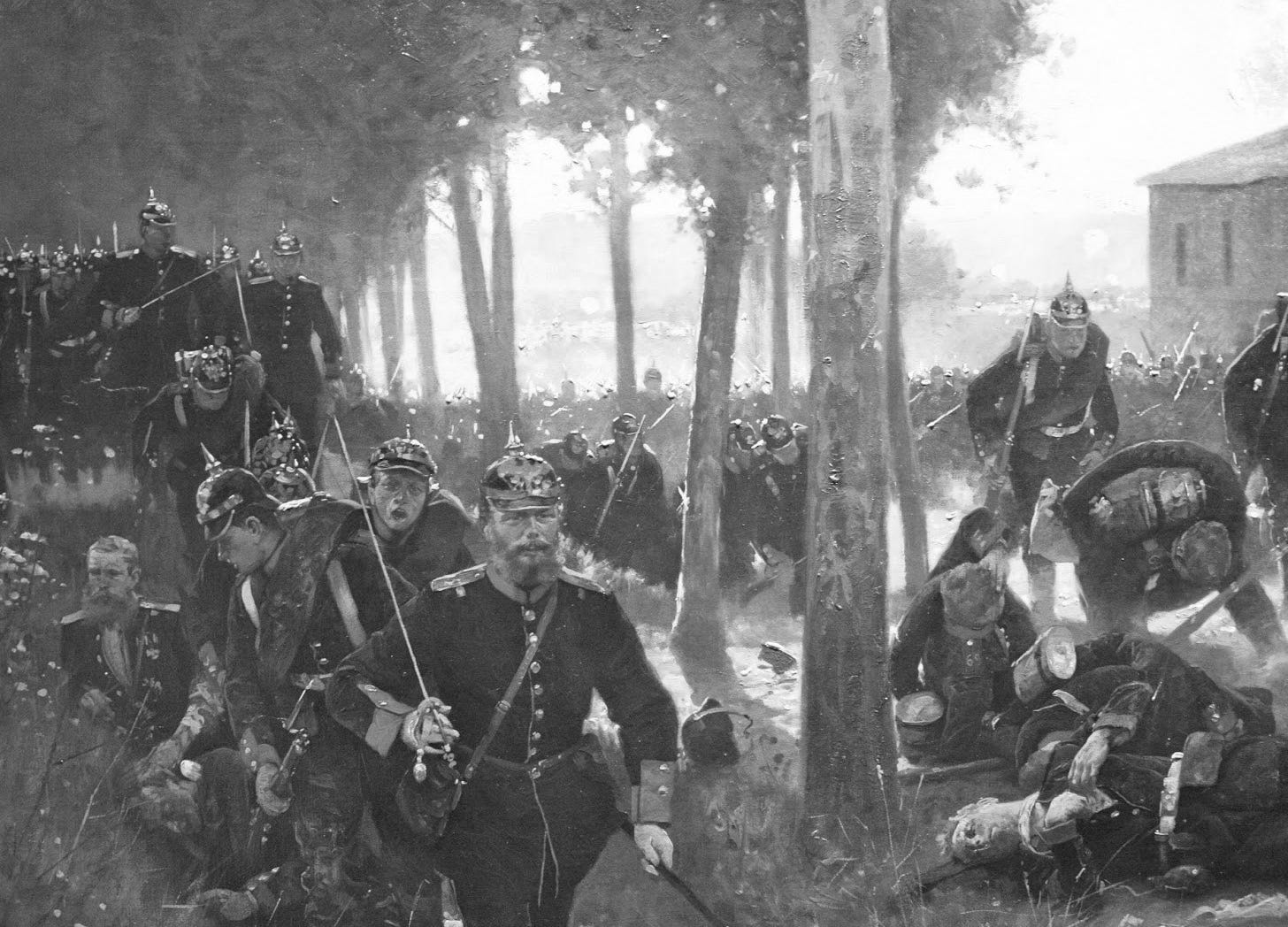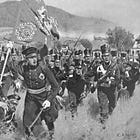This is the eleventh post in a multi-part series. To find previous installments and those that follow, please consult the following guide.
In the meantime the battalion reserves, with drums beating, approached the foot of the height. A company marched in the rear of each flank, and the third company in rear of the center of the firing line.
The remainder of the supports, consisting of a platoon on each flank of the firing line, could now be pushed up. These platoons stood in single rank, under cover, so that they had merely to march straight forward to prolong the flanks of the firing line.
The reinforcement took place as follows: It was laid down that, in the at- tack, every reinforcement to the fighting line should give the impulse for a fresh rush. When the advancing platoon, with drums beating, arrived within 130 yards of the firing line, all its leaders blew a shrill note on their whistles to warn the firing line. The platoons nearest to it in the firing line repeated this whistle, and then commands were issued for hotter volley firing.
When about thirty-five yards behind the firing line, the leader of the reinforcements gave another whistle and the command, ‘Double’. This whistle was also repeated in the firing line, and the flank platoon leader gave the command, ‘Slope arms - muzzles well up.’ (The other platoons increased their fire.)
After the reinforcing platoon had rushed past the flank of the firing line some fifty yards, the other platoons of the same company followed at once, and the central company somewhat later.
Though the firing line was not required to preserve any fixed line of advance, yet each platoon had to take up its firing position so as to conform to those of the nearest platoons, and to insure the most effective fire. The only circumstances under which a platoon was allowed to pass beyond the general line in advancing was when the enemy could not be seen or hit from the position the platoon would have occupied if it had conformed to the general alignment.
When one platoon was thus obliged to advance, the nearest platoons at once conformed to its movement. It was considered to imply a want of courage if a platoon, to obtain good cover, posted itself in such manner that it prevented the next platoon on its right or left either wholly or in part from firing.
‘Forward, forward!’ cried a platoon leader as his platoon in its advance suddenly came on a dry ditch, which would have given ample cover for several platoons. ‘Over!’ he shouted again, and he cleared the ditch with a long leap. Then halting, he looked round to see that his men had not lain down. Some tumbled in, one was wounded, another seemed to be unconscious. Two men were pulled out, and hurried on behind. The leader thus succeeded in bringing his company some twenty yards nearer to the bare spot it had to occupy.
‘What a difference between the old days and now!’ I exclaimed. “How many a captain of my day would have rejoiced to meet such a ditch! How the men would have thrown themselves in heaps, and not have left an inch unoccupied! How hard it would have been to get them out again in order to advance.
The former friend is the present enemy, formerly greeted with joy, now shunned like the plague. But in this matter I am not on the side of the good old times. The same ditch that this platoon disregarded and left behind it, would formerly have absorbed the fighting strength of a whole company.”
In the meantime, the gaps in the center of the firing line of each battalion had been increased considerably by the losses they had suffered. A company from the battalion reserves was directed to fill up this gap. The company selected was the one marching in the rear of the center of the fighting line, and was, at the time I speak of, under cover at the foot of the height.
The company was standing in line. The company chief gave the usual command: ‘First and fourth platoons to the firing line.’
On this these platoons moved forward on the command of their leaders and extended inwards: the first platoon to the left, the fourth to the right, the single rank formation being attained by the rear rank men moving up on the left of their front rank men. All ordered arms. The platoon leader placed himself in front of the right flank man of the second half platoon, and the platoon touched towards this man. The company chief followed at about 100 yards; the support remained under cover.
The gap in the second battalion was not large enough to leave room for two platoons. That did not cause any difficulty, because the platoons had been trained to form two ranks when there was not room in the firing line. The reinforcement by the new platoons, through the center of the firing line, took place in precisely the same manner as I described before in the case of those on the flanks.
The men who had to rush through part of the prostrate firing line had orders, if any men did not raise their muzzles high, or if any were taking aim, to seize such men’s rifles and take them with them for a few paces.
Moreover, it was not necessary for the firing line to remain lying down until the reinforcement had passed through it, and had taken up its position in front. Since, as a principle, the choice of the moment for a rush was left entirely to the platoon leaders, it often happened that a company advanced from the firing line simultaneously with the reinforcement or before it reached the line. The reinforcement then had to conform to the front of such company.
Our last rush had brought a line, dense and without gaps in the best order to between 300 and 400 yards of the enemy. The fire was well in hand. The battalion reserves were under cover 300 yards behind this line. They consisted of a company in rear of the outer flank of each battalion and a half company in rear of the center of each battalion. The regimental reserve had advanced and stood in company columns or company lines under cover ready to advance farther when required.
To be continued …
Soon after an installment of this series appears in the pages of The Tactical Notebook, a link to it will appear on the following guide.






